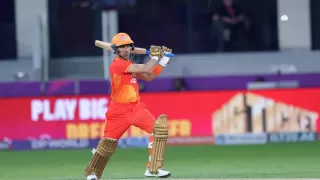UEFA Nations League History and Winners List

Image Source: X
UEFA Nations League History and Winners List: Portugal's 40-year-old striker Cristiano Ronaldo has also got poetic justice. How important this trophy is for Ronaldo, who scored a goal to equalise in the final match of the UEFA Nations League, was clearly evident from his emotions after the team's victory in the penalty shootout. In the thrilling final match held in Munich, Portugal defeated defending champion Spain 5-3 in the penalty shootout.
UEFA Nations League Seasons and Winners: A Look
So far, four (4) seasons of the UEFA Nations League have been played successfully, and each season has created its own unique stories:
1. 2018-19 Season: First Champion - Portugal

Image Source: X
This was the inaugural season of the Nations League, which gave football lovers a new thrill. Portugal won the first title by defeating Netherlands 1-0 in the final. The Cristiano Ronaldo-led Portuguese team registered this historic win on their home soil, giving this new tournament a great start. This season also showed how teams like Georgia from League D also came close to making it to Euro 2020 through the playoffs.
2. 2020-21 Season: France shines

Image Source: X
Despite the COVID-19 pandemic, this season was successfully concluded. France and Spain faced each other in the final. France won the title by defeating Spain 2-1 in a thrilling match. Stars like Kylian Mbappe and Karim Benzema played a key role in France's victory. This season further cemented the growing popularity and competitive nature of the competition.
3. 2022-23 Season: Spain's Comeback

Image Source: X
The third season saw Spain avenge their previous loss. In the final, they beat Croatia in a penalty shootout to lift the trophy. It was a very close contest, with both teams displaying great football. Spain's young and talented team showcased their potential to win the Nations League title for the first time.
4. 2024-25 Season: Portugal's Second Title

Image Source: X
This season has just ended, and Portugal once again showcased their strength to win their second Nations League title by defeating the Netherlands in the final. This shows that Portugal continues to be a dominant force in international football and they continue to dominate this tournament.
Also Read: Photos and videos of Portugal victory celebrations
UEFA Nations League: How Does This League Work?
The format of the UEFA Nations League is quite unique and structured. The 55 member associations of UEFA are divided into four leagues (League A, B, C, and D) based on their ranking. Each league is further divided into four groups.
League A: It consists of the top ranked teams in Europe. The teams in this league compete for a place in the 'Finals'. Four teams participate in the Finals, which determine the winner through semi-finals and a final.
Leagues B, C, and D: Teams in these leagues play for promotion (moving to the next league) and demotion (moving to the previous league). Teams that top their group are promoted to the next league, and those that finish at the bottom are demoted.
European Championship Qualification: Some playoff spots for the European Championship are also determined through the Nations League, giving teams an additional opportunity to qualify.
This format ensures that every match counts, and teams are motivated to perform better consistently.
Why was the UEFA Nations League needed?
In international football, the time between major tournaments such as the World Cup and the European Championship was often filled with friendly matches. These matches were sometimes not that attractive for spectators, and also had low motivation for players. UEFA understood this problem and conceived of a competition that would:
Increase competition: Every match has something at stake, whether it is promotion, relegation or the chance to qualify for the European Championship.
Give opportunities to weaker teams: Teams were divided into different leagues according to their strength, giving them the opportunity to play against teams of a similar level.
Reduce friendly matches: Reduce the workload of players by reducing unnecessary travel and less important matches.
With this idea, the UEFA Nations League was born.
Also Read: Virat Kohli HD Wallpaper with IPL Trophy 2025
Disclaimer
Possible11 is a sports news platform that provides live scores, player statistics, and tournament updates for informational and educational purposes only. We comply with the Online Gaming Bill, 2025 (India) and do not promote or engage with fantasy sports, betting, or real-money gaming platforms. All content is intended solely to enhance the sports experience. Possible11 is not affiliated with any fantasy or gambling applications and is not responsible for any financial gains or losses incurred on external platforms.












Give Your Feedback